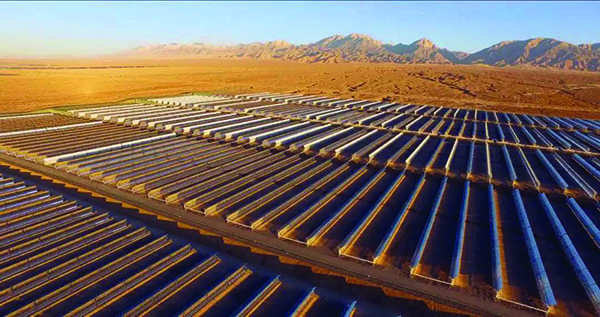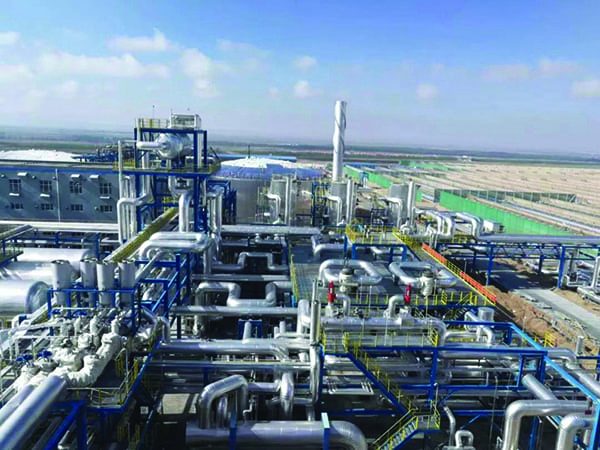China Puts Online Pioneering Large-Scale CSP Project
China completed its first large commercial-scale parabolic-trough concentrated solar power (CSP) plant at the end of June. The 50-MW Delingha project built by CGN New Energy, a subsidiary of China General Nuclear Power Corp. (CGN), is located on 2.46 square kilometers in the northwestern province of Qinghai.
The plant (Figure 4) comprises 9,120 single-trough collectors arranged in 192 “loops,” whose layout and design was adapted to local wind loads, sloped ground, and low temperatures. Solar receivers in the troughs transfer heat from the sun to the thermal oil at a high efficiency. The plant is also equipped with nine hours of molten salt thermal storage. Heat is transferred from the salt to the steam in the steam generator system. The 380C steam produced (Figure 5) drives a 50-MW steam turbine-generator set, which is grid-connected. According to CGN, the process ensures “stable and continuous power generation for 24 hours.”
Because the project is built on a sparsely populated plateau about 3,000 meters above sea level, the CSP project posed unique challenges during construction. CGN said it considered cold temperatures and oxygen-deficiency problems on the plateau when it mapped out an implementation plan for the project. The site’s challenges, specifically, prompted the company to consider a novel technology to inject heat transfer oils step by step, which differs from the conventional practice of injecting oils all at once, CGN said.
For China, completion of the CSP project marks a major technical and developmental milestone. While the country added nearly 200 GW of solar photovoltaic (PV) capacity over the last decade—growth driven by plunging costs of PV modules and incentives—progress concerning CSP technology has been slow. A major hurdle for widespread CSP technology in China and across the world has been costs and technology associated with economies of scale and efficiency. As CGN noted in July, China is only the eighth country in the world to have a large solar thermal power station.
According to the Fraunhofer Chile Research Center for Solar Energy Technology (CSET), at the end of 2017, only 6 GW of CSP capacity had been installed worldwide; 80% was parabolic trough, and the remainder was solar tower technology. About 70% had storage. Across the CSP market, costs in 2017 ranged between $48/MWh for a 390-MW tower with 13 hours of thermal energy storage in Chile and $73/MWh in the United Arab Emirates for a 200-MW tower with eight to 10 hours of thermal energy storage.
CSP is generally seen as less competitive on the basis of dollars per MWh, but because it is now being understood that its value relies on its dispatchable attribute, more projects are being tendered with technology-specific tariffs, according to Professor Frank Dinter, director of the CSET. “This means that the optimum design and operation of each plant is unique to each tender and location,” he said in April. Dinter suggested that costs for parabolic trough and solar towers will fall between 33% and 37% by 2025, compared to 2015, owing largely to market developments and technology advancements.
China, which set a 10-GW target for CSP capacity by 2020 in its 13th five-year plan, is leading the world’s efforts. The country has announced 20 pilot CSP projects worth a combined 4,512 MW. On Delingha’s heels is the 100-MW Shouhang Dunhuang molten salt solar tower project, which is slated for completion in August 2018. Others in the pipeline are the 100-MW Royal Tech project, the 50-MW Jinfan Akesai project, and the 50-MW Royal Tech Yumen project, all slated for completion by the end of 2018.
For CGN, which began building Delingha in August 2015, CSP is promising. The company notes that CSP enjoys “greater developmental potential” compared to PV power, owing to its continuous and steady generation of electricity. As well as improving regional power system stability, the Delingha project will offer crucial data and experience that will be leveraged to build China’s future large CSP projects, many of which are planned in desert areas. The project has also prompted CGN to build a national research center for solar and thermal energy, it said, which will “propel China’s CSP industry and play an exemplary role in the design of China’s trough-type solar and thermal power systems, [research and development], and setting standards.”
—Sonal Patel is a POWER associate editor.

